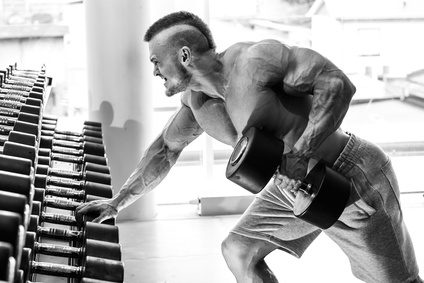DUMBELL ROWING FORWARD - MUSCLES INVOLVED
Im Schultergelenk: The middle and posterior deltoid muscles, infra-spinatus, Teres minor, Lattissimus dorsi, Teres major, and supraspinatus act as auxiliary muscles in this exercise.
Im Schultergürtel: the midsection of the trapezius and the entire rhomboid muscle.
DUMBELL ROWING FORWARD - THE MOVEMENT

Horizontal pull in the shoulder joint - also known as horizontal extension. When moving backwards from a position in front of the body, the upper arm remains perpendicular to the trunk. In the stooped position, the upper arm describes a vertical line and remains perpendicular to the trunk. In the shoulder girdle, which is made up of the collarbone and the bones of the shoulder blade, the shoulder blade is tightened.
SPORTS: Movement is most important in the sport,
from which it takes its name, the rowing. It is also extremely important for the archery train. For tennis, badminton and similar sports.
EXECUTION: Stand crouched next to an exercise bench. Your feet should be about shoulder-width apart, your back straight, and your legs slightly tense in your knees and hips. Support the body by placing the arm facing the bench on the top of the bench. The dumbbell is in line with your torso just in front of your outer foot on the floor. Grasping the dumbbell moves the shoulder downward, using the shoulder girdle and shoulder joint muscle, raise the dumbbell and focus on raising the elbow. Push your elbow back so that you are holding the weight next to you.
DUMBELL ROWING FORWARD - ACTION
Lower the dumbbell to the floor in a controlled manner. After completing the repetitions of the set, move to the other side of the bench and repeat the exercise with the other arm. The rest of the body should remain at rest during the exercise
You can do the exercise at two speeds. First, at a slow to medium pace, which is best if this is your first time training. Once the muscles are fairly well developed and used to the exercise, you can pull the weight up with a harder pull.
You should always work against the resistance of the weight, making sure that the bar never swings freely.
already read..?
A comment
Comments are closed.